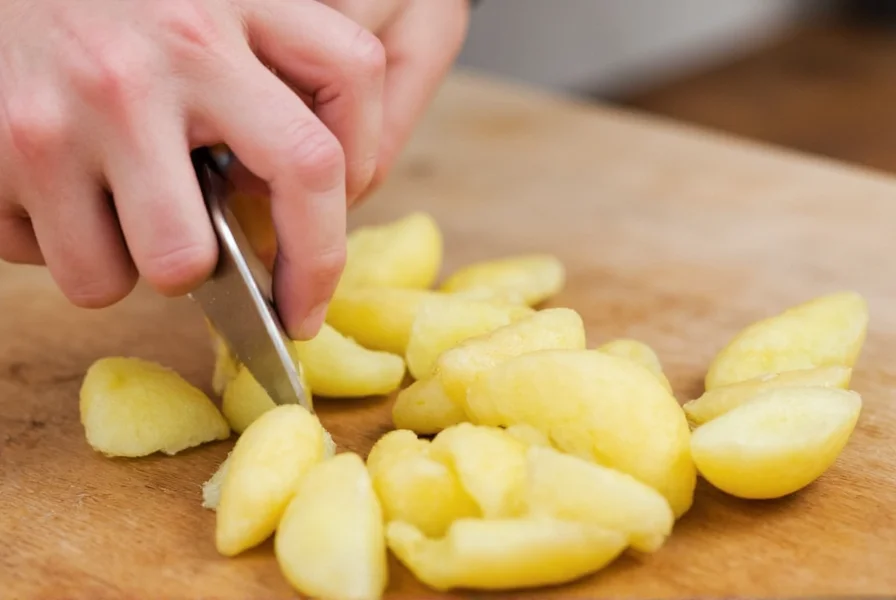Mastering the art of chopping ginger transforms your cooking experience. Properly prepared ginger releases optimal flavor compounds essential for Asian cuisine, baking, and wellness teas. Unlike improper techniques that bruise fibers and diminish potency, the right method ensures consistent texture and maximum aromatic impact in every dish.
Essential Tools for Chopping Ginger
Before learning how to chop ginger root effectively, gather these kitchen essentials:
| Tool | Best For | Alternative |
|---|---|---|
| Chef's knife (8-inch) | Precise chopping and mincing | Utility knife |
| Spoon (tablespoon) | Peeling without waste | Vegetable peeler |
| Stable cutting board | Safe chopping surface | Any non-slip board |
Step-by-Step Ginger Chopping Technique
1. Selecting and Preparing Your Ginger
Choose firm, smooth ginger roots with taut skin—avoid shriveled or moldy sections. Refrigerated ginger becomes harder to work with, so use room-temperature roots. For the best way to chop ginger root, start by breaking off a manageable piece (about 2-3 inches) at a natural joint in the rhizome.
2. Peeling Without Waste
Forget traditional peelers that remove too much valuable flesh. The professional method for how to properly prepare ginger for cooking involves using a spoon's edge:
- Hold ginger firmly in one hand
- Scrape the spoon's edge along the skin's surface
- Apply gentle pressure to remove only the thin outer layer
- Rotate ginger and repeat until completely peeled
This technique preserves up to 30% more usable ginger compared to conventional peeling methods.
3. Slicing Against the Grain
Examine your peeled ginger to identify the fiber direction (grain). For optimal texture when learning how to chop ginger for stir-fry or other dishes:
- Cut crosswise against the grain into 1/8-inch thick slices
- Stack 3-4 slices for efficient chopping
- Hold your knife tip down while rocking the blade
4. The Rock-Chop Method
Master ginger chopping techniques for beginners with this professional approach:
- Position knife tip on cutting board
- Grip handle firmly with dominant hand
- Lay non-dominant hand flat on blade spine
- Rock knife back and forth in smooth motion
- Maintain consistent pressure for uniform pieces
For fine mince, gather chopped pieces and repeat the rocking motion while adding a pinch of salt to prevent sticking.
Avoiding Common Ginger Chopping Mistakes
Many home cooks make these critical errors when attempting how to chop ginger properly:
- Using a dull knife - Crushes fibers instead of cutting cleanly
- Chopping with the grain - Creates stringy, uneven pieces
- Peeling too deeply - Wastes up to 40% of usable ginger
- Rushing the process - Leads to inconsistent sizes and potential injury
Specialized Ginger Cutting Techniques
Different recipes require specific ginger preparations. Understanding ginger chopping techniques for beginners helps you adapt to various culinary needs:
Julienne Cut (Matchstick)
Ideal for stir-fries and garnishes. After peeling, cut ginger into 2-inch lengths, then slice into thin planks. Stack planks and cut lengthwise into 1/8-inch strips.
Fine Mince
Essential for marinades and sauces. After initial chop, sprinkle with salt and continue rocking knife until paste-like consistency forms. The salt absorbs moisture and prevents oxidation.
Ginger Paste
For curry bases and medicinal preparations. Combine chopped ginger with minimal water in mortar and pestle, grinding in circular motion until smooth.
Storing Chopped Ginger Properly
Preserve your freshly chopped ginger with these professional storage methods:
- Refrigerate in airtight container for up to 3 weeks
- Freeze in ice cube trays covered with neutral oil
- Store in dry sherry for up to 6 months (traditional method)
- Never store peeled ginger in water—it dilutes flavor
Why Proper Ginger Preparation Matters
The way you chop ginger directly impacts your dish's flavor profile. Scientific studies show that cutting ginger releases different volatile compounds than grating or crushing. Cross-grain chopping maximizes zingiberene (the primary flavor compound) while minimizing harsh bitterness. This explains why professional chefs insist on proper ginger preparation techniques for authentic Asian cuisine.

FAQ: Ginger Chopping Questions Answered
Can I chop ginger in a food processor?
While possible, food processors often over-process ginger into a paste. For proper texture control, hand-chopping yields superior results. If using a processor, pulse in one-second bursts with minimal liquid to maintain distinct pieces.
How fine should I chop ginger for stir-fry?
For stir-fry, aim for 1/8-inch pieces. This size ensures even cooking without burning while releasing optimal flavor. Larger pieces won't distribute flavor evenly, while finer mince may burn during high-heat cooking.
Why does my ginger stick to the knife?
Ginger's natural oils cause sticking. Prevent this by lightly oiling your knife blade before chopping, using a pinch of salt during mincing, or chilling the ginger for 10 minutes prior to preparation. A sharp knife also reduces sticking significantly.
Should I remove ginger's eyes before chopping?
Only remove significantly sprouted eyes (green growths). Small imperfections don't affect flavor. Focus on removing only damaged or moldy sections. The eyes themselves contain concentrated flavor compounds valuable for cooking.
How long does freshly chopped ginger last?
Properly stored in an airtight container in the refrigerator, chopped ginger maintains peak quality for 7-10 days. Beyond this, flavor compounds degrade and moisture loss occurs. For extended storage, freeze in oil cubes for up to 6 months without quality loss.










 浙公网安备
33010002000092号
浙公网安备
33010002000092号 浙B2-20120091-4
浙B2-20120091-4